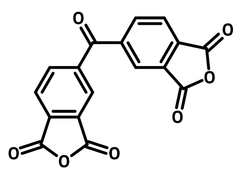3,3',4,4'-Benzophenonetetracarboxylic dianhydride (BTDA)
CAS Number 2421-28-5
Chemistry Building Blocks, COF Ligands, Diamines and Dianhydrides, Heterocyclic Building Blocks, Materials, Monomers,A benzophenone-cored dianhydride building block
As an intermediate for the synthesis of polyimides in application of photosensitizers, high-performance polymers and OFETs
Specifications | MSDS | Literature and Reviews
3,3',4,4'-Benzophenonetetracarboxylic dianhydride (BTDA, CAS number 2421-28-5) is derived from benzophenone with two dianhydride on both terminals. The primary use of 3,3',4,4'-Benzophenonetetracarboxylic dianhydride is for synthesizing polyimide with primary amines undergoing nucleophilic substitution followed by condensation reactions. Benzophenone-cored polyimide is used in photocatalytic dye degradation applications such as methylene blue in water. Potentially it can extend its applications to dye-sensitized solar cells (DSSCs) and photocatalytic reactions.
The polyimide/copolymer formed by BTDA has shown high thermal stability and good mechanical properties. This polyimide is an electret and used as a dielectric layer for high performance OFET memory devices.
Benzophenone building block
for the synthesis of OLED and organic photovoltaic materials
Worldwide shipping
Quick and reliable shipping
Capped wtih tetracaboxylic anhydride
for facile reactions
High purity
>98.5% Purity
General Information
| CAS Number | 2421-28-5 |
| Chemical Formula | C17H6O7 |
| Full Name | 3,3',4,4'-Benzophenonetetracarboxylic dianhydride |
| Molecular Weight | 322.23 g/mol |
| Synonyms | Benzophenone-3,3′,4,4′-tetracarboxylic dianhydride 4,4′-Carbonyldiphthalic anhydride BTDA |
| Classification / Family | Benzophenone derivatives, Dianhydride building blocks, Polyimides, OFETs, Photosensitizers |
Chemical Structure

Product Details
| Purity | >98.5% |
| Melting Point | Tm = 218 °C – 222 °C |
| Appearance | White to off-white powder |
MSDS Documentation
3,3',4,4'-Benzophenonetetracarboxylic dianhydride (BTDA) MSDS Sheet
Literature and Reviews
-
Developing high-efficiency π conjugated polymer semiconductor for photocatalytic degradation of dyes under visible light irradiation, S. Chu et al., RSC Adv., 4, 57153-57158(2014); DOI: 10.1039/C4RA11345D.
-
Electrospun antibacterial poly(vinyl alcohol)/Ag nanoparticles membrane grafted with 3,3′,4,4′-benzophenone tetracarboxylic acid for efficient air filtration, S. Li., Appl. Surf. Sci., 533, 147516(2020); DOI: 10.1016/j.apsusc.2020.147516.
-
Intrinsically negative photosensitive polyimides with enhanced high-temperature dimensional stability and optical transparency for advanced optical applications via simultaneous incorporation of trifluoromethyl and benzanilide units: preparation and properties, Y. Gao et al., polymers, 14, 3733(2022), DOI: 10.3390/polym14183733.
